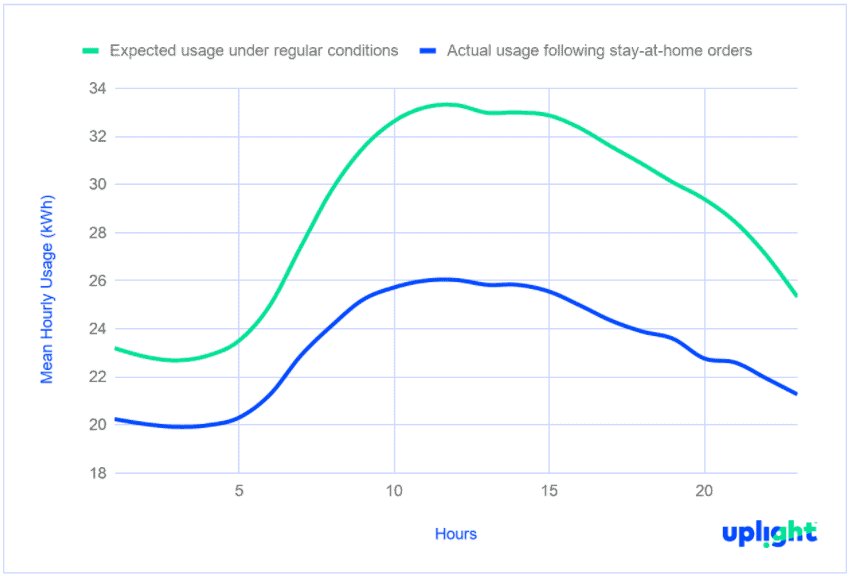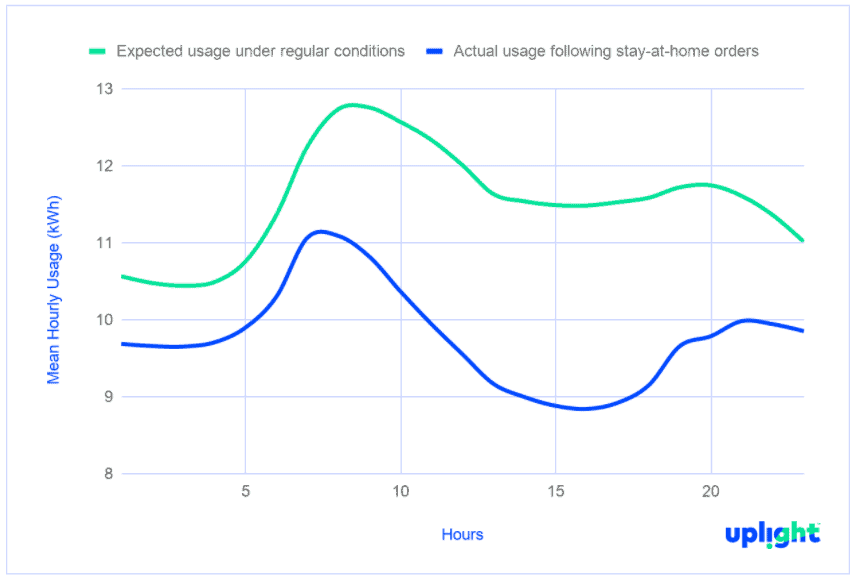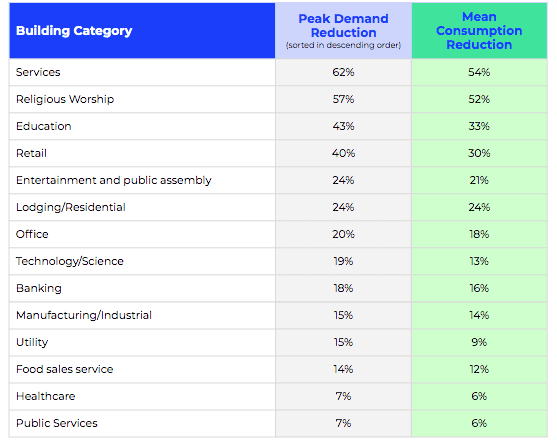With COVID-19 stay-at-home orders in place nationwide, more people are working from home and making less trips to businesses–often only going out for essential items like groceries. We at Uplight wanted to uncover how this impacted non-residential energy usage and what this means for utilities. We analyzed two weeks of AMI data following quarantine orders from two utilities in two different geographic regions. Our models use the past 15 months of data and control for temperature, weather, daylight savings times and weekend versus weekday use.


Not surprisingly, we found that energy usage was down, declining 15-19% overall. Peak loads declined from 13-22%, following a similar pattern. While load shapes are largely unchanged, in both normal and “duck curved” load patterns, with peak times and load patterns remaining roughly the same.
More interestingly is that energy loads vary widely across business sizes, customer segments and regions.

- In one region, micro-businesses have been the most impacted, with 30% energy reductions, while the largest businesses (those over 10GWh annually) were only down 13%. The second region had less variation. 10GWh and under businesses had a decreased load of 13-17% and larger businesses were only down by 6% in contrast. Especially for larger businesses, the dominant local industries and their ability to be open during the pandemic impacts these trends.
- Essential businesses have been the least affected as one would expect, but also saw decreases in energy consumption. Both healthcare and banking experienced a 9-16% decrease, while grocery stores only had between a 5 and 7% decline.
- Non-essential businesses, particularly those based on larger gatherings of people, have much more drastic declines. Services, like dry cleaners, are down 45-54% and education is down 33-46%. Places of worship have also been less frequented, with 33-46% less energy usage. Lodging and hotels have an average 24% reduction, and retail a 17-30% reduction. Many restaurants have been able to operate at a limited capacity, decreasing their energy use anywhere from 15-30%.
What it means for utilities and their customers
Even as stay-at-home orders are relaxed in the coming months, many businesses will still need to operate with limitations or at a reduced capacity–continuing to affect the non-residential energy loads. Utilities will experience:
- Reduced overall grid strain in the near term – From a utility perspective, these changes reduce near-term strain on the grid at a system level. When combined with usage and peak load increases in the residential sector, the net system usage and load declines are on the order of 4-8%. This should, in turn result in lower overall system costs typically associated with high peak loading during the cooling season. On the other hand, some typical non-residential demand response resources may be less available than usual, increasing the need for new DR (both residential and non-residential) during summer peak events.
Utilities with significant Solar PV deployment, either at a system level, or at a circuit level, may experience these changes more dramatically than other utilities with low Solar PV.
- Impacts on Billing and Revenue – In addition to the impact on overall local economy and residential customers, the decline of non-residential load creates revenue challenge for utilities. First, many modern rate cases include significant revenue attached to peak loading, particularly in business tariffs, and these appear that they may be down by an average of 13-20%, and potentially more based on which individual large businesses are most impacted in a utilities territory. In addition, many businesses may find themselves in arrears, or those that have gone out of business will be unable to pay a few months of utility bills.
- Challenges in meeting energy efficiency goals – Fewer businesses and less capital are available to focus on energy efficiency investments, creating new challenges in meeting non-residential EE/DSM targets. Further, many forms of onsite work have been at least temporarily halted during quarantine periods. We have heard in the market that several businesses have taken advantage of workers absent from offices and buildings to accelerate completion of projects in flight where construction/improvement carried on as essential businesses. Uplight recommends taking a segment based approach to re-targeting efficiency programs. Based on the data, verticals that have been less impacted may have more available capital or interest in
- Importance of Economic Recovery – Helping businesses get back on their feet. Most utilities are thinking about how to help businesses come back. Some are down temporarily, while others have gone out of business or are in dire straits.
Next Steps: How utilities can act with their business customers
In response, utilities can help their non-residential customer optimize their energy usage based on their particular region and segment and strengthen the utility-customer relationship through personalized and proactive communications.
- Program and support strategies – The data clearly shows that segment-based strategies are needed in each utility territory. Utilities should use both their analytics capabilities and non-residential customer relationships to determine which local businesses are most in need of assistance, and think about which existing or edited programs to best fit the needs of each segment. Analytics at an account level can be further used to drive target lists and estimate impact for new or timely non-residential programs like billing, DR or energy efficiency.
- Enable inbound communications – Use existing non-residential touchpoints and tools to support communications with customers, providing better advice and information, while keeping call center costs low. Business customers calling with bill concerns are also interested in advice on bill savings. Utilities with Uplight non-residential engagement tools already in place are already prepared to serve their customers with business-specific advice. Many energy and bill savings tips are free to act on, for example adjusting start times and set points for building temperature controls. Prior Uplight studies have shown that nearly half of the energy waste in a building comes from operational setting like these, rather than issues that require retrofits. Also free to customers – switching to a better rate plan. Analytics based rate tools (self-service, through the call center or via account managers) help customers find their best business rate for their new normal of operations.
- Enable proactive communications from account managers – Existing tools can also help to support outbound, proactive calls with larger customers, allowing account managers in any segment to quickly identify, target and advise customers over the phone on ways to keep their bills lower.
- Start or expand digital communications – Key communications like high usage alerts and high bill alerts have never been more valued by business customers, helping them to see what they’re using and manage precious cash in intervals before their bill arrives.
The COVID-19 pandemic continues to affect all aspects of our lives, including energy usage. With 15-19% declines overall and some non-residential segments experiencing up to a 54% decrease in load, utilities are experiencing both benefits and challenges at the same time. With an increase in residential usage, there could be less strain on the grid, but at the same time revenue and energy efficiency targets could be impacted. By developing a proactive communication strategy that addresses the specific needs of each business segment and region, utilities can continue to be the trusted energy advisor for their customers, both now and after the COVID-19 pandemic.
Uplight will continue to conduct analysis over time, update results as they emerge, and add C&I customer results to our analysis. Subscribe to the Uplight blog to get the latest updates!





